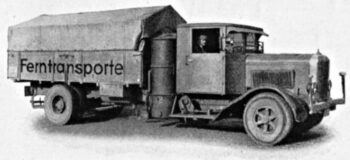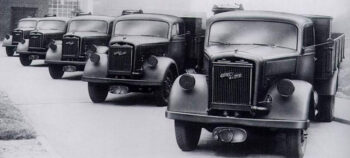Producer Gas

The early era of industrialization was an era of coal and coke. Steam machines were driven by coke and coal fires, homes were heated with them, food was cooked with them, and an entire industry evolved around producing coke from coal and using the by-product – “coal gas” or “city gas” – to provide heating, cooking and lighting gas for entire towns and cities. However, a large fraction of city gas is carbon monoxide (CO), which is highly lethal to warm-blooded animals. Accidental deaths and suicides with this gas were quite common.
Exterminators recognized early on that mice and rats could be gassed using the ubiquitous city gas, but the procedure was unsafe for humans. In the early 1900s, the German medical professors Bernhard Nocht and Gustav Giemsa developed a fumigation method using CO that did not used piped city gas, but rather a separate device that produced gas rich in CO on demand in a defined manner. These devices were called producer-gas generators, and the fumigation method thus developed was called the Nocht-Giemsa method. Their device burned coke with limited amounts of oxygen, thus producing a gas with some 5% of CO. However, since insects are not sensitive to CO, this method was only suitable to kill warm-blooded pests, such as mice and rats. Before, during and after World War One, it was a very common method to combat these types of vermin in freight ships and storage facilities in harbors.

When Germany and her allies were cut off from foreign oil supplies by the Allied naval blockade during World War Two, producer-gas generators became an important technology for the Axis powers in Europe. These devices could be fired with wood, coal or coke, and could be tweaked to contain as much as 35% of CO. Such a fuel gas was perfectly capable of driving Germany’s entire civilian transportation sector and also her military vehicle fleet, making her war machine largely independent of oil.
In an effort to accelerate the transition from liquid fuel to this type of gaseous fuel, the German government issued decree after decree, making the switch compulsory for a growing part of Germany’s vehicle manufactures. Producer-gas generators were mass-produced by the hundreds of thousands. The technology was actively promoted by the highest quarters, including Adolf Hitler, Hermann Göring and Albert Speer. Hence, they all knew that Germany had hundreds of thousands of poison-gas generators everywhere.
In fact, during the war, Germany was a country built on carbon-monoxide technology in general, not just for propulsion. Large chemical factories existed, and new ones were built, which turned coal into a type of producer gas, again rich in CO, which was converted to several basic chemicals (such as methanol) needed for synthesizing more complex chemicals, such as artificial rubber.

The amount of CO produced in Germany during the war years to drive its vehicle fleet and to feed its vast chemical factories would have sufficed to kill the entire world population many times over. This transition to an economy built on coal turned hundreds of thousands of vehicles into potentially highly lethal gas vans, since their fuel gas – but not their exhaust gas – was extremely lethal. In addition, this toxic fuel gas could easily be ventilated, since it doesn’t adhere to anything and doesn’t dissolve in anything – quite in contrast to the rare and expensive hydrogen cyanide.
Therefore, when the so-called “Final Solution” was reaching its peak in 1942 and 1943, Germany had tens of thousands of engineers and mechanics familiar with this lethal-gas technology, hundreds of thousands of drivers capable of operating these devices, and an equal number of these poison-gas devices present literally everywhere, with no limitation on fuel.
Yet no one has ever claimed that this technology was used to kill even one single person.
(For details, see Kalthoff/Werner 1998, pp. 31-36; Rudolf 2024a, pp. 453-457).

You need to be a registered user, logged into your account, and your comment must comply with our Acceptable Use Policy, for your comment to get published. (Click here to log in or register.)